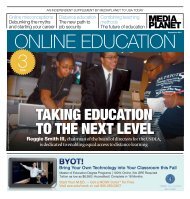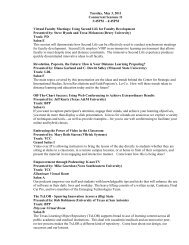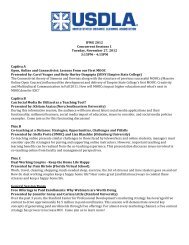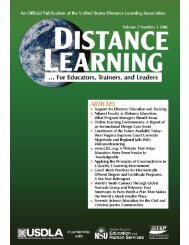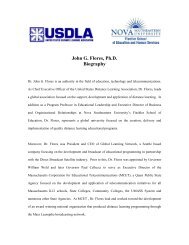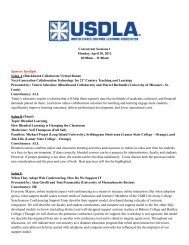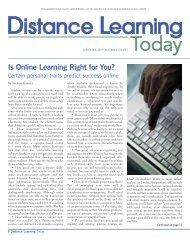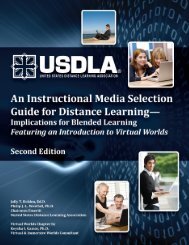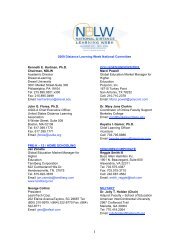United States Distance Learning Association
United States Distance Learning Association
United States Distance Learning Association
- No tags were found...
You also want an ePaper? Increase the reach of your titles
YUMPU automatically turns print PDFs into web optimized ePapers that Google loves.
that allow instructors and students to do<br />
presentations, share whiteboard activities,<br />
and share desktop applications with the<br />
capability of hearing and seeing each<br />
other. Student polling and break-out<br />
rooms for group activities all add to the<br />
interactive environment. Instructors can<br />
hold virtual office hours, Webcasts, and<br />
bring in guest lecturers. In addition, sessions<br />
can be archived for future viewing.<br />
Teaching online has now been taken to a<br />
new level, but faculty remain cautious in<br />
the adoption of this technology.<br />
This article will examine factors related<br />
to the diffusion of the Wimba Live Classroom<br />
technology using Rogers’ (1995)<br />
framework for diffusion of innovation.<br />
Recommendations for adoption and<br />
implementation of this technology will be<br />
provided.<br />
BACKGROUND<br />
The study takes place at a minority-serving<br />
4-year university where the student enrollment<br />
is 87% Hispanic, specifically Mexican<br />
American. Most of the students are commuters<br />
and also work while attending<br />
school full time. Accessibility and flexibility<br />
of curriculum delivery are significant<br />
issues for this population. Taking fullyonline,<br />
hybrid, and Web-augmented<br />
courses both synchronously and asynchronously<br />
may contribute to ease of access for<br />
course completion and retention of students<br />
Culture impacts on learning styles, and<br />
in this case it is an important factor for consideration<br />
in curriculum design (Chan,<br />
2003). Mexican American culture is collectivist<br />
and high context where communication<br />
is indirect and rich in nuance and<br />
meaning (Hofstede, 2001). This type of<br />
communication style uses both verbal and<br />
nonverbal cues that can be afforded in a<br />
face-to-face situation. It would seem then,<br />
that, considering this audience, the use of<br />
Wimba Live Classroom that simulates<br />
authentic communication, would be essential<br />
for student satisfaction and effective<br />
delivery of curriculum.<br />
In 2005, Wimba Live Classroom was<br />
introduced to this university community<br />
via the Center for <strong>Learning</strong>, Teaching &<br />
Technology (CLTT). The Center maintains<br />
the WebCT course management system<br />
and has supported over 12,000 students in<br />
over 650 courses that are delivered in Webaugmented,<br />
hybrid, and fully-online formats.<br />
In addition, CLTT is responsible for<br />
the research and dissemination of new<br />
educational technologies campus-wide.<br />
CLTT also provides full training and support<br />
for faculty in the appropriate pedagogical<br />
use of educational technology for<br />
delivery of curriculum.<br />
Live Classroom represented a new technology<br />
for the faculty and sparked their<br />
interest in terms of their consideration for<br />
teaching online courses. The use of a live<br />
virtual classroom addressed the issue of<br />
maintaining effective communication and<br />
interaction. Faculty were now more willing<br />
to entertain the possibilities that technology<br />
now afforded for online teaching.<br />
Two faculty teaching graduate courses<br />
in linguistics were actively recruited to use<br />
Live Classroom. Both faculty had taught<br />
internationally and were open to the possibilities<br />
that Live Classroom had to offer.<br />
Both had a foreign student overseas that<br />
they wanted to bring into their class that<br />
they were teaching on-site. Their plan was<br />
to use Live Classroom for one semester<br />
and see how it worked. One was a new<br />
faculty member and the other was a senior<br />
faculty member. The training occurred in<br />
the following steps:<br />
1. Completion of the Live Classroom<br />
online one-hour training session sponsored<br />
by Wimba.<br />
2. A practice session with instructional<br />
developers at the Center for <strong>Learning</strong>,<br />
Teaching & Technology.<br />
3. A face-to-face Live Classroom session<br />
with students conducted in a computer<br />
lab. Instructors are located in the<br />
Volume 4, Issue 4 <strong>Distance</strong> <strong>Learning</strong> 49



